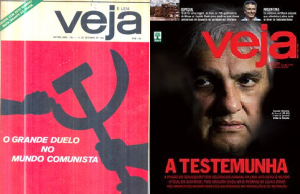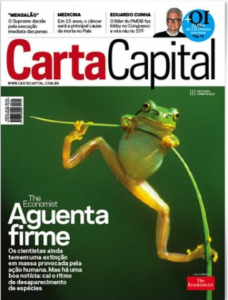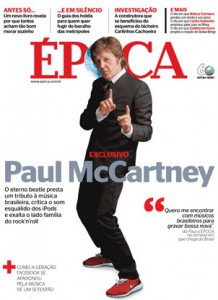The Media in Brazil – Part II Posted by carol on Dec 4, 2015 in Uncategorized
Following the other post concerning Brazil’s most important newspapers, we are going to learn a little more about the country’s top revistas (magazines). The focus will be on three established news magazines being published in the country which have great influence over several aspects of Brazilian culture and society and serve as an important fonte de informação (source of information).
VEJA
Veja was created in 1968 and it is today the magazine with the largest national circulation (with a print run over a million copies) and the greatest number of assinaturas (subscriptions) in the country. It is also the biggest weekly publication outside of the U.S. Veja’s editorial line was inspired by the Times magazine and its subjects cover several themes such as world news, science and technology, business, history, celebrities, health, welfare, society, lifestyle, fashion, culture, cinema, religion and more.
Veja began as a center-leftist magazine but after the 1990’s it got cada vez mais (increasingly more) inclined to the right. It is nowadays largely associated with the setores de direita da sociedade (right-wing sectors of the society), being more conservative and liberalism-oriented. The magazine has been the target of criticism and protest for their support to parties during presidential elections, even facing several processos judiciais (lawsuits) from parties and individual politicians.
Veja is the main flagship from Editora Abril, which is a major publishing and printing company in Latin America, currently publishing other 21 magazines among other businesses.
website in English: http://vejainternational.com/
CARTA CAPITAL
Carta Capital was founded in 1994 by the journalist Mino Carta, who was also involved in the creation of Veja. The magazine was concebida (conceived) as an alternative to the main publications that dominated the market at the time. Its editorial profile has progressively changed to become what has been called by some “journalistic activism”, for their frank apoio (support) to social causes and leftist parties.
Carta Capital also has a bigger take on culture featuring articles and opinions on art, history and philosophy. It is also the magazine which features less propagandas (adverstisements) in comparison with the other ones mentioned in this post. Its crew is composed by only 11 journalists and althought it has a national circulation, the printing company resposible for it is also considerably modest.
ÉPOCA
Época was founded in 1998 drawing inspiration from the German magazine ‘Focus’, notable for uma abordagem mais gráfica (a more graphic approach) of the information and a careful treatment of the images. It is edited by Editora Globo, which is one of the world’s most powerful media corporations, owner of Brazil’s biggest and most influential television network and Rio de Janeiro’s main newspaper ‘O Globo’. Época currently ranks in the second place among the best selling magazines, right after Veja.
The stories featured in Época tend to be shorter and more illustrated, often showing a more informal tone. Nonetheless, the magazine has also been involved in polictical scandals and accusations of corruption. Given the influence of its publishing company, Época also has right-wing inclinations. The issues covered include politics and economy, science, technology, religion, ecology, arts and culture.
http://epoca.globo.com/
Por hoje é só (That’s it for today), espero que tenham aproveitado a leitura! (Hope you enjoyed the reading)

Build vocabulary, practice pronunciation, and more with Transparent Language Online. Available anytime, anywhere, on any device.






